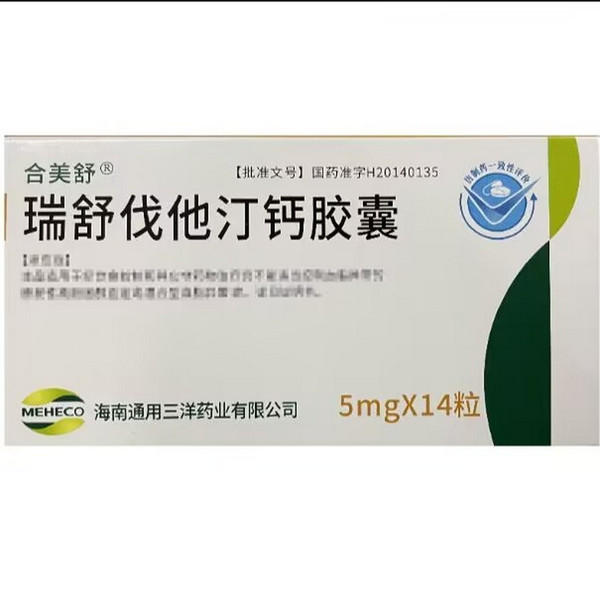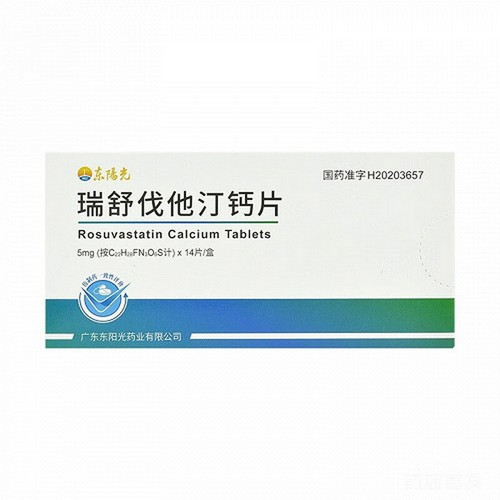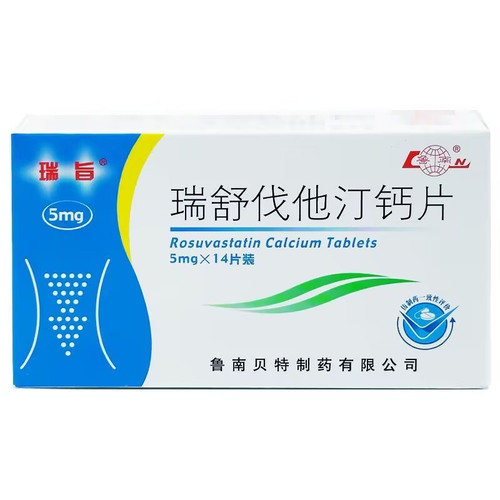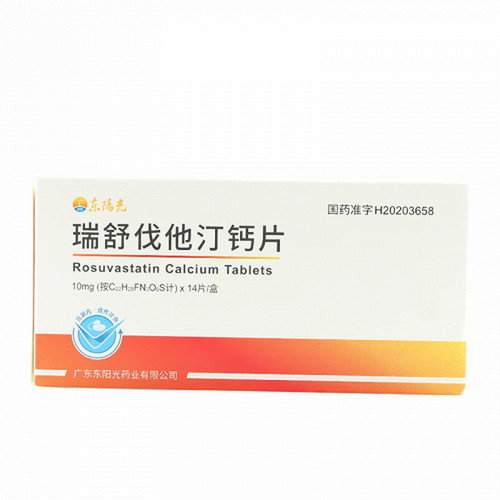Product Overview
[Drug Name]
Generic Name: Rosuvastatin Calcium Capsules
Trade Name: Hemisu Rosuvastatin Calcium Capsules 5mg x 14 capsules
[Main Ingredients]
Rosuvastatin calcium.
[Properties]
This product is a capsule containing white or off-white granules.
[Indications/Main Functions]
1. This product is indicated for patients with primary hypercholesterolemia (type Ia, including heterozygous familial hypercholesterolemia) or mixed dyslipidemia (type Ib), whose dyslipidemia is not adequately controlled with diet and other non-drug therapies (e.g., exercise therapy, weight loss). 2. This product is also indicated for patients with homozygous familial hypercholesterolemia as an adjunct to diet and other lipid-lowering measures (e.g., LDL-C depletion therapy), or when these measures are inadequate.
[Specifications]
5mg x 14 capsules
[Dosage and Administration]
1. Patients should be placed on a standard cholesterol-lowering diet prior to treatment and should maintain this diet during treatment. The use of this product should be individualized, taking into account the patient's individual cholesterol level, anticipated cardiovascular risk, and potential risk of adverse reactions. 2. Oral: The typical starting dose of this product is 5 mg once daily. The selection of the starting dose should take into account the patient's individual cholesterol level, anticipated cardiovascular risk, and potential risk of adverse reactions. For patients requiring more intensive low-density lipoprotein cholesterol (LDL-C) lowering, a starting dose of 10 mg once daily can be considered; this dose controls lipid levels in most patients. If necessary, the dose can be adjusted to the next higher dose level after four weeks of treatment. The maximum daily dose of this product is 20 mg. 3. This product can be taken at any time of day, with or without food. 4. Use in Patients with Renal Impairment: No dose adjustment is required for patients with mild and moderate renal impairment. All doses of this product are contraindicated in patients with severe renal impairment. 5. Use in Patients with Hepatic Impairment: Systemic exposure of rosuvastatin is not increased in subjects with a Child-Pugh score of 7 or less. Elevated systemic exposure was observed in subjects with Child-Pugh scores of 8 and 9. In these patients, renal function should be evaluated. There is no experience with the use of this product in patients with Child-Pugh scores exceeding 9. This product is contraindicated in patients with active liver disease. 6. Race: Increased systemic exposure has been observed in Asian subjects. This factor should be considered when determining the dosage for patients of Asian descent.
[Adverse Reactions]
1. Adverse reactions observed with this product are generally mild and transient. In controlled international clinical trials, less than 4% of patients withdrew due to adverse events. The frequency of adverse events is as follows: common (incidence >1/100, <1/10); uncommon (>1/1000, <1/100); rare (>1/10,000, <1/100); and very rare (<1/10,000). 2. Immune system abnormalities. Rare: Allergic reactions, including angioedema. 3. Neurological abnormalities. Common: Headache, dizziness. 4. Gastrointestinal Disorders. Common: Constipation, nausea, abdominal pain. 5. Skin and Subcutaneous Tissue Disorders. Rare: Pruritus, rash, and urticaria. 6. Skeletal Muscle, Joint, and Bone Disorders. Common: Myalgia. Rare: Myopathy and rhabdomyolysis. 7. Systemic Disorders. Common: Asthenia. As with other HMG-CoA reductase inhibitors, the incidence of adverse reactions with this drug tends to increase with increasing dose. 8. Renal Effects: Proteinuria (as determined by dipstick) has been observed in patients receiving this drug, with the majority of the protein originating from the renal tubules. Approximately 1% of patients experienced an increase in proteinuria from absent or trace amounts to + or greater at certain times during treatment with the 10 mg and 20 mg doses, and approximately 3% of patients receiving the 40 mg dose experienced this increase. With the 20 mg dose, increases in proteinuria from absent or trace amounts to a mild + were observed. In most cases, proteinuria spontaneously decreased or resolved with continued treatment. 9. Effects on Skeletal Muscle: Skeletal muscle effects, such as myalgia, myopathy, and rarely, rhabdomyolysis, have been reported in patients receiving all doses of this drug, particularly in patients receiving doses greater than 20 mg. Dose-related increases in creatine kinase (CK) levels have been observed in patients taking this drug; most cases have been mild, asymptomatic, and transient. If CK levels are elevated (>5× ULN), treatment should be discontinued. 10. Effects on the Liver: As with other HMG-CoA reductase inhibitors, dose-related elevations in transaminases have been observed in a small number of patients taking this drug; most cases have been mild, asymptomatic, and transient. Postmarketing Experience: In addition to the reactions described above, the following adverse events have been reported during postmarketing use of this drug: 11. Hepatobiliary Disorders: Very rare: Jaundice, hepatitis. Rare: Elevated liver transaminases. 12. Musculoskeletal Disorders: Rare: Arthralgia. 13. Neurologic Disorders: Very rare: Polyneuropathy.
[Contraindications]
1. This product is contraindicated in patients with active liver disease.
2. It is not used in patients with renal impairment. No dosage adjustment is required for patients with mild or moderate renal impairment. All doses of this product are contraindicated in patients with severe renal impairment. It is not used in patients with hepatic impairment.
[Drug Interactions]
1. Cyclosporine: When this product is coadministered with cyclosporine, the AUC of rosuvastatin is, on average, 7-fold higher than that observed in healthy volunteers (compared to the same dose of this product). Coadministration does not affect cyclosporine plasma concentrations. 2. Vitamin K Antagonists: As with other HMG-CoA reductase inhibitors, initiating or increasing the dose of this product may result in an increase in the International Normalized Rate (INR) in patients taking concomitant vitamin K antagonists (e.g., warfarin). Discontinuing or decreasing the dose of this product may result in a decrease in the INR. In such cases, appropriate INR monitoring is necessary. Gemfibrozil and Other Lipid-Lowering Products: Concomitant use of this product with gemfibrozil may increase the Cmax and AUC of rosuvastatin by 2-fold. Based on data from dedicated interaction studies, no pharmacokinetic interaction is expected between this product and fenofibrate, but a pharmacodynamic interaction may occur. Concomitant use of gemfibrozil, fenofibrate, other fibrates, and lipid-lowering doses of niacin (1 g/day) with HMG-CoA reductase inhibitors increases the risk of myopathy, likely due to the myopathy they can cause when taken alone. 3. Antacids: Concomitant administration of this product with an anti-lipid suspension containing aluminum magnesium hydroxide reduces rosuvastatin plasma concentrations by approximately 50%. This effect is mitigated if the antacid is administered 2 hours after taking this product. The clinical significance of this drug interaction has not been studied. 4. Erythromycin: Concomitant use of this product with erythromycin results in a 20% decrease in the AUC(O-t) and a 30% decrease in the Cmax of rosuvastatin. This interaction may be due to increased gastrointestinal motility caused by erythromycin. 5. Oral Contraceptives/Hormone Replacement Therapy (HRT): Concomitant use of this product with oral contraceptives increases the AUC of ethinyl estradiol and norgestrel by 26% and 34%, respectively. These increases in plasma concentrations should be considered when selecting oral contraceptive dosages. There are no pharmacokinetic data on subjects taking this product concomitantly with HRT; therefore, the possibility of a similar interaction cannot be ruled out. However, in clinical trials, this combination was widely used and well tolerated by patients. 6. Other Drugs: Based on data from dedicated drug interaction studies, no clinically relevant interactions are expected between this product and digoxin. Cytochrome P450 Enzymes: Both in vitro and in vivo data indicate that rosuvastatin is neither an inhibitor nor an inducer of cytochrome P450 isoenzymes. Furthermore, rosuvastatin is a weak substrate for these enzymes. No clinically relevant interactions were observed between rosuvastatin and fluconazole (an inhibitor of CYP2CP and CYP3A4) or ketoconazole (an inhibitor of CYP2A6 and CYP3A4). Coadministration with itraconazole (a CYP3A4 inhibitor) increased the AUC of rosuvastatin by 28%, an increase not considered clinically significant. Therefore, drug interactions due to cytochrome P450-mediated metabolism are not expected.
[Precautions]
1. Effects on the kidneys. Proteinuria (as measured by dipstick) has been observed in patients treated with high doses, particularly 40 mg. The majority of the protein is derived from the renal tubules and, in most cases, is transient or intermittent. 2. Effects on skeletal muscle. Skeletal muscle effects, such as myalgia, myopathy, and, rarely, rhabdomyolysis, have been reported in patients treated with all doses of this drug, particularly in doses greater than 20 mg. 3. Creatine kinase testing. Creatine kinase (CK) should not be measured after strenuous exercise or in the presence of plausible factors that could cause CK elevation, as this can confound interpretation of the results. If baseline CK values are significantly elevated (>5×ULN), retesting should be performed within 5-7 days. If repeat testing confirms a baseline CK value >5×ULN, treatment should not be initiated. As with other HMG-CoA reductase inhibitors, this drug should be used with caution in patients with predisposing factors to myopathy/rhabdomyolysis. These factors include renal impairment. Hypothyroidism. Personal or family history of hereditary muscle disease. History of muscle toxicity with other HMG-CoA reductase inhibitors or fibrates. Alcohol abuse. Age > 70 years. Elevated blood drug concentrations may occur. Concomitant use of fibrates. For these patients, the possible benefits of treatment should be balanced against the potential risks, and clinical monitoring is recommended. If the patient's baseline CK value is significantly elevated (>5×ULN), treatment should not be initiated. During treatment, patients should be asked to immediately report unexplained muscle pain, weakness, or cramping, especially if accompanied by malaise and fever. CK levels should be measured in these patients. If CK values are significant (>5×ULN) or muscle symptoms are severe and cause daylong malaise (even if CK is ≤5×ULN), treatment should be discontinued. If symptoms resolve and CK levels return to normal, consider restarting this product or switching to the lowest dose of another HMG-CoA reductase inhibitor and closely monitor patients. Routine CK level monitoring is not necessary for asymptomatic patients. In clinical studies, there was no evidence of increased effects on skeletal muscle in the small number of patients receiving this product concurrently with other treatments. However, an increased incidence of myositis and myopathy has been observed in patients receiving other HMG-CoA reductase inhibitors concomitantly with fibrates (including gemfibrozil), cyclosporine, niacin, azole antifungals, protease inhibitors, or macrolide antibiotics. Concomitant use of gemfibrozil with some HMG-CoA reductase inhibitors may increase the risk of myopathy. Therefore, coadministration of this product with gemfibrozil is not recommended. The benefits of combining this product with fibrates or niacin to further improve lipid levels should be carefully weighed against the potential risks of this combination. This product should not be used in any patient with an acute, severe illness suggestive of myopathy or with renal failure predisposing to rhabdomyolysis (such as sepsis, hypotension, major surgery, trauma, severe metabolic, endocrine, or electrolyte abnormalities, or uncontrolled epilepsy). 4. Effects on the Liver. As with other HMG-CoA reductase inhibitors, this drug should be used with caution in patients who consume alcohol excessively and/or have a history of liver disease. Liver function tests are recommended before starting treatment and within three months after initiation. If serum transaminases are elevated more than three times the upper limit of normal, this drug should be discontinued or the dose reduced. For hypercholesterolemia secondary to hypothyroidism or nephrotic syndrome, the underlying disease should be treated before initiating this drug. Ethnicity: Pharmacokinetic studies have shown that drug exposure is higher in Asian subjects than in Caucasians. Effects on Driving and Operating Machinery: Studies to determine the effects of this drug on driving and operating machinery have not been conducted. However, based on its pharmacodynamic properties, this drug is unlikely to affect these abilities. The potential for dizziness during treatment should be considered when driving or operating machinery.
[Pediatric Use]
The safety and efficacy of this drug in children have not been established. Pediatric experience is limited to a small number of children (aged >8 years) with homozygous familial hypercholesterolemia. Therefore, this drug is not currently recommended for pediatric use.
[Use in Elderly Patients]
No dose adjustment is required.
[Overdose]
There is no specific treatment for overdose with this drug. In the event of an overdose, symptomatic treatment should be initiated, with supportive measures employed as needed. Liver function and CK levels should be monitored. Hemodialysis may not be significantly effective.
[Pharmacology and Toxicology]
Rosuvastatin is a selective, competitive HMG-CoA reductase inhibitor. HMG-CoA reductase is the rate-limiting enzyme in the conversion of 3-hydroxy-3-methylglutaryl-CoA to mevalonate, a cholesterol precursor. Animal and cell culture studies have shown that rosuvastatin is highly and selectively taken up by the liver, making the liver a target organ for cholesterol-lowering effects. In vitro and in vivo studies have shown that rosuvastatin increases the number of hepatic LDL receptors on cell surfaces, thereby enhancing LDL uptake and catabolism. It also inhibits hepatic VLDL synthesis, thereby reducing the total number of VLDL and LDL particles. Rosuvastatin can lower total cholesterol, LDL-C, ApoB, and non-HDL-C levels in patients with homozygous and heterozygous familial hypercholesterolemia, non-familial hypercholesterolemia, and mixed dyslipidemia. It can also lower triglycerides (TG) and increase HDL-C levels. In patients with isolated hypertriglyceridemia, rosuvastatin can lower total cholesterol, LDL-C, VLDL-C, ApoB, non-HDL-C, and TG levels, while increasing HDL-C levels. The effect of rosuvastatin on cardiovascular morbidity and mortality has not been established. Toxicology Studies: Central Nervous System Toxicity: Several studies of similar drugs in dogs have demonstrated CNS vascular damage, including perivascular hemorrhage, edema, and perivascular mononuclear cell infiltration.






